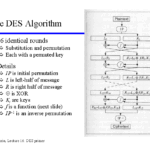In the realm of cryptography, the terminology can often lead to confusion, particularly when it comes to the classification of encryption algorithms. One persistent question that arises is whether RSA, a widely recognized asymmetric encryption algorithm, qualifies as a block cipher. To navigate this inquiry, it is vital to dissect the characteristics of both RSA and block ciphers, thereby illuminating the distinctions and overlaps that exist between them.
To begin with, it is essential to delineate what constitutes a block cipher. A block cipher is an encryption algorithm that transforms fixed-size blocks of plaintext into ciphertext using a symmetric key. This means that the same key is utilized for both the encryption and decryption processes. Popular examples include AES (Advanced Encryption Standard), DES (Data Encryption Standard), and Blowfish. Block ciphers operate on specific-sized blocks of data, typically 64 or 128 bits, and apply a series of operations that include substitution, permutation, and transposition within those blocks. The outcome is the transformation of plaintext to ciphertext in a manner that is both secure and efficient.
On the flip side, RSA (Rivest-Shamir-Adleman) embodies a fundamentally different approach to encryption. Developed in 1977, RSA is an asymmetric cryptographic system that employs two distinct keys: a public key for encryption and a private key for decryption. This dual-key mechanism allows for secure data transmission without necessitating the prior exchange of secret keys, which is a significant advantage in secure communications. RSA operates on numerical values that can vary significantly in size, depending on the key length used, but does not confine itself to fixed-size blocks of data in the same way that block ciphers do.
The disparity in operation is where the confusion often lies. While both RSA and block ciphers serve the purpose of encrypting data, their methodologies, use cases, and structural designs are markedly different. Block ciphers, for instance, are ideally suited for encrypting large datasets or streams of data because of their efficiency in processing fixed-size blocks. In contrast, RSA is primarily used for encrypting small amounts of data, such as symmetric keys or digital signatures, due to its computational expense and the overhead associated with key management.
Furthermore, RSA encrypts data mathematically rather than through iteration over fixed blocks. The core of RSA’s security hinges on the difficulty of factoring large integers, a challenge that forms the basis of its encryptive strength. When a message is encrypted using RSA, it is transformed using modular exponentiation with a public key, resulting in a ciphertext that is a function of that key. Thus, the transformation does not mirror the block manipulation characteristic of traditional block ciphers.
Despite these distinctions, there is a nuanced interplay between RSA and block ciphers in practical implementations, particularly in hybrid cryptosystems. In these systems, the efficiency of block ciphers can be combined with the security properties of RSA. For example, a common scenario is the use of RSA to encrypt a randomly generated symmetric key, which is subsequently used with a block cipher to encrypt the actual data. This approach capitalizes on the strengths of both encryption methods, utilizing RSA’s security for key exchange while leveraging the speed of block ciphers for data encryption.
The operational efficiency of block ciphers contrasts sharply with the resource-intensive nature of RSA. The latter requires extensive computational resources, particularly as key sizes increase. This characteristic makes RSA less practical for encrypting large amounts of data directly. Users must remain cognizant of the need for suitable key sizes to ensure security, which introduces additional complexities into the implementation. As a result, in scenarios requiring the secure transmission of bulk data, relying solely on RSA is rarely the optimal approach.
When examining the entirety of the landscape, it becomes evident that RSA cannot be categorized as a block cipher. This classification confusion stems from the distinct operational methodologies, key management strategies, and intended use cases of these algorithms. The classification of RSA as a block cipher disregards its inherent design principles, which anchor it firmly in the realm of asymmetric cryptography.
In conclusion, the inquiry into whether RSA is a block cipher reveals fundamental truths about cryptographic categorization. Understanding these differences is integral to appreciating the strengths and limitations of various encryption techniques. While block ciphers excel in efficiency and speed, RSA offers robust security features that are invaluable for specific applications, particularly in the realm of secure communications and key exchange. The synergy between asymmetric and symmetric encryption methodologies underscores the evolving nature of cryptography, where a nuanced approach is essential for achieving robust security in an increasingly complex digital world.








Leave a Comment